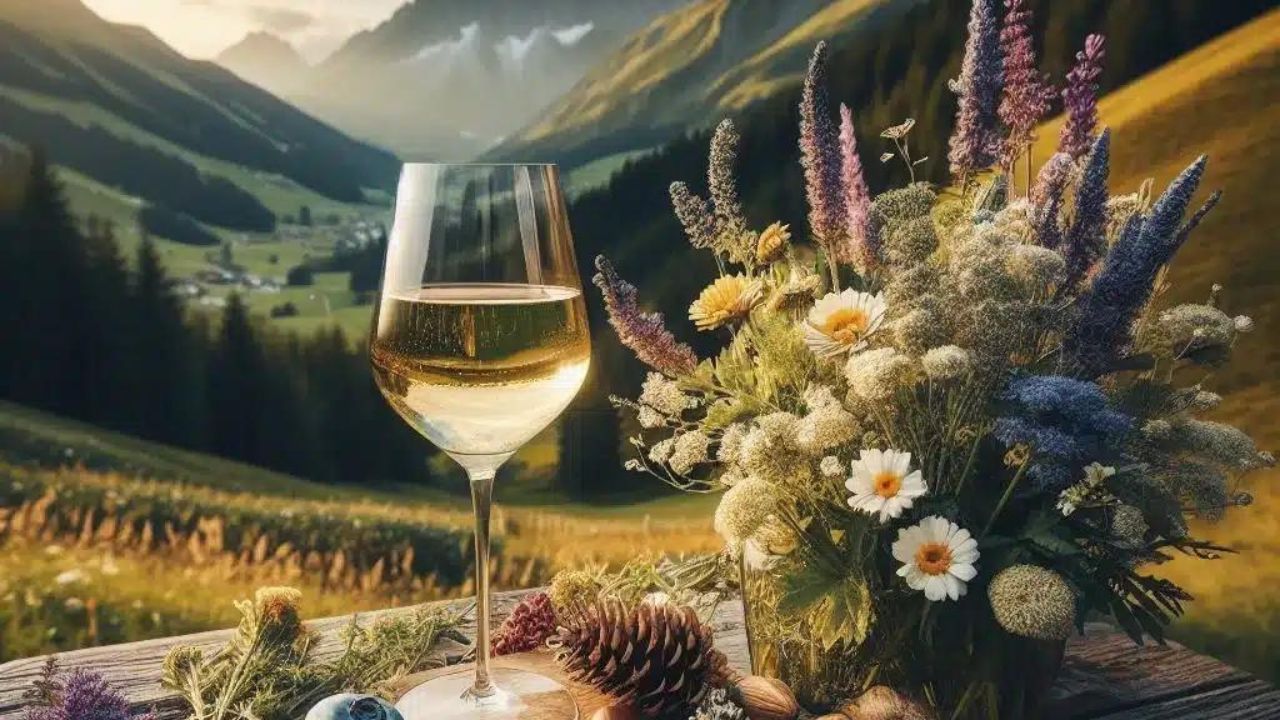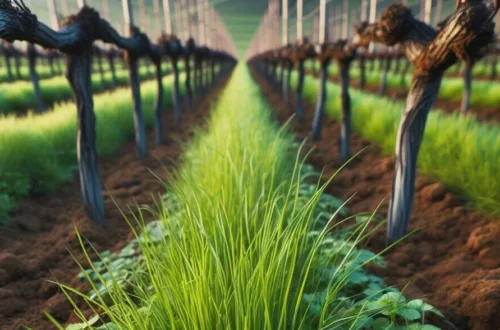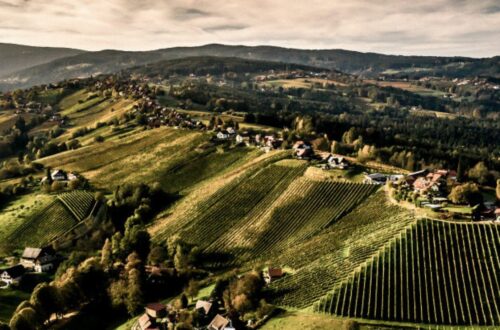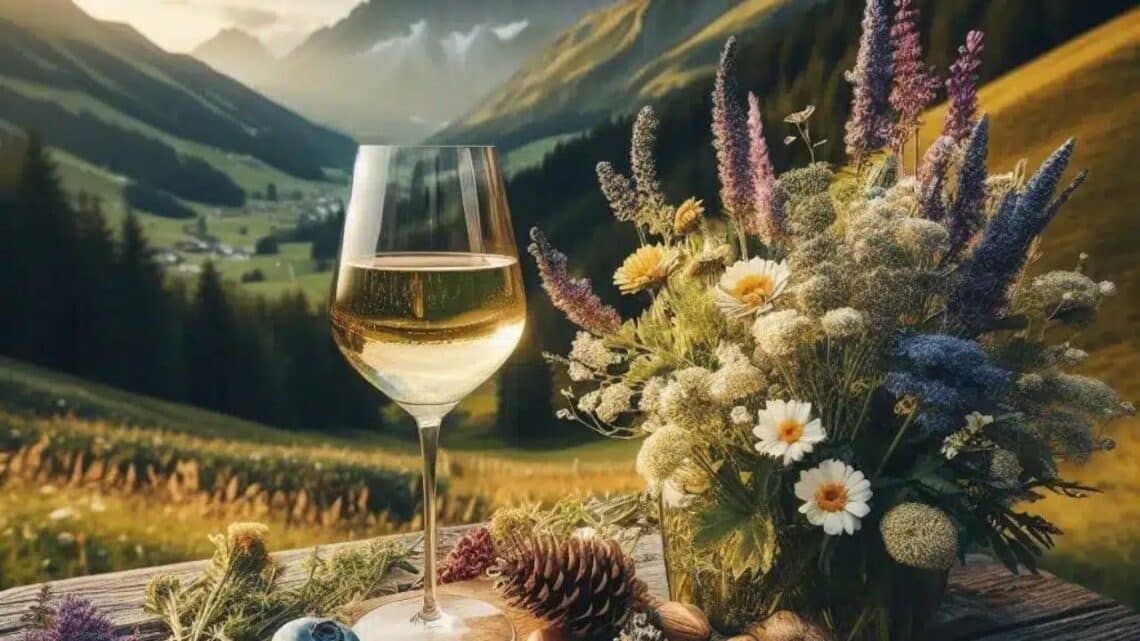
Unique characteristics of Grüner Veltliner wine from Wachau
If you’ve been following this blog for a while, the main grape varieties in Austria that come to mind are Grüner Veltliner and Riesling for the whites and Zweigelt, Blaufränkisch and Saint-Laurent for the reds.
Indeed, Austria is best known for its wines made from indigenous grape varieties, Grüner Veltliner being the most widely planted.
Even though Grüner Veltliner can be found in any wine regions of Austria, it is at its best in Niederösterreich, and more precisely in Wachau. Moreover, this region is beautiful to visit, so it’s a win win!
So, through this post, let’s discover the unique characteristics that make Wachau’s Grüner Veltliner exceptional.
Grüner Veltliner’s fame may have boomed in the 50s, but early methods yielded uninteresting wines. Thankfully, Wachau’s climate gifts us Grüner Veltliners with zippy acidity, hints of citrus, herbs, and white pepper. These age beautifully, transforming into honeyed and toasty delights. “Klassik” styles see stainless steel tanks, while “Reserve” embraces new oak. Grüner Veltliner’s versatility shines with food pairings – it tackles fish, spicy Asian fare, and even creamy Austrian classics, all thanks to its high acidity and refreshing peppery notes. To find the best, seek out “Smaragd” on the label – these top-tier wines often boast higher alcohol content.
- A Grape with a Rich Heritage
- Capturing Wachau’s Terroir in the Glass
- A Symphony of Aromas
- A Palate of Balance and Elegance
- How to serve Grüner Veltliner wine?
- Versatility and Food Pairing
- Age-Worthiness and Maturation
- Additional tips for you!
- Conclusion: Unique characteristics of Grüner Veltliner wine from Wachau
A Grape with a Rich Heritage
The exact origins of Grüner Veltliner are unknown, but it is believed to have originated in Austria, possibly in the Wachau region. The grape was first mentioned in written records in the 14th century, and it quickly became one of the most popular grape varieties in Austria.
Grüner Veltliner is a crossing of the Traminer (Savagnin) grape and an obscure Austrian grape variety. The grape is well-suited to Austria’s climate and soils, and it produces wines with a wide range of flavors and aromas, including high acidity, minerality, and fruit flavors.
In the 1950s, Lenz Moser developed a high-training method for Grüner Veltliner vines, which allowed for greater mechanization and yields. However, this method was later found to reduce ripeness levels, and it is no longer widely used.
Today, Grüner Veltliner is the most widely planted white grape variety in Austria. It is also grown in other parts of the world, including Germany, Slovenia, and the United States.
Here are some of the key points about the origins of Grüner Veltliner:
- The grape is believed to have originated in Austria, possibly in the Wachau region.
- Grüner Veltliner is a crossing of Traminer (Savagnin) and an obscure Austrian grape variety.
- The grape is well-suited to Austria’s climate and soils, and it produces wines with a wide range of flavors and aromas.
- In the 1950s, Lenz Moser developed a high-training method for Grüner Veltliner vines, but this method is no longer widely used due to its negative impact on ripeness levels.
- Today, Grüner Veltliner is the most widely planted white grape variety in Austria.
Capturing Wachau’s Terroir in the Glass
In the Wachau, you’ll mostly find granite soils. These soils are often fissured which allows the vine roots to delve into the soil. This brings freshness to the wines. And isn’t freshness what you’re looking for in your typical Grüner Veltliner?
However, this is not all you find, on the hillsides, you’ll also find gneiss and loess. These soils are rich and mineral and will bring complexity to the wines.
So, to sum up, Grüner Veltliner in Wachau will be fresh and complex, thanks to the soils.
The Wachau region is subject to two meteorological forces : the hot air from the Pannonian plains and the cold wind from the Weinviertel. This leads to a significant difference in temperature between day and night, and especially in the summer, which is the season just before harvest.
This helps keep the acidity high while letting the aromas develop and thus brings complexity and a robust structure to the wines.
So, with Wachau’s terroir (remember, terroir is soil and climate), Grüner Veltliner will produce complex wines with a robust structure while remaining fresh.
So, as said earlier, Grüner Veltliner is not grown ONLY in the Wachau. If you want to know more about the impact of terroir of the other regions, this post will give you an overview of Grüner Veltliner elsewhere in Austria.
A Symphony of Aromas
Grüner Veltliner wines can be made in two styles.
It can be vinified in the “Klassik” version, this means the wines are fermented and aged in stainless steel containers. The wines will then have a crispy attack, have high acidity and will present aromas of green apple, citrus, stone fruits and white pepper. The finish is usually long and very refreshing.
A quick word on the white pepper. It is due to a cheminal compound, called Rotundone, that was discovered on the skin in 2008. This molecule was discovered late because it was first thought that pepper was a complex interaction between other odors.
Skin contact will enhance the pepperiness in the wine.
ANECDOTE : By the way, this molecule, rotundone, is also present on Syrah, grown in the northern Rhône Valley or in the state of Victoria in Australia, or on Gamay from Beaujolais crus. Other French grape varieties, such as Duras, Mondeuse or Mourvèdre can also have some peppery notes, although these notes appear more often in cooler areas or vintages. Indeed, rotundone prefers cooler temperatures (less than 25°C), hence its presence on Grüner Veltliner grapes in Austria. Winemaking techniques (fermentation temperature, time of maceration seeing as skin contact will enhance the pepperiness in the wine) can also influence the final concentration of rotundone. Rotundone however is stable in the bottle and its concentration will not change with the wine ageing.
It can also be vinified in the “Reserve” version, meaning it will be aged in barrels, new oak. This will bring strong vanilla and toast aromas to the wines.
With age, it will develop aromas of honey and toast.
A Palate of Balance and Elegance
The acidity is high, tannins inexistant. The wines can be made in dry or sweet style, although in Wachau, it is very often dry. Sweet wines are mostly found in Burgenland.
Concerning the body, then again, all depends on how the wine was vinified.
In the “Klassik” case, Grüner Veltliner wines are low-bodied. The high acidity makes the wine very refreshing and lively on the palate.
Grüner Veltliner wines have a yellow straw colour with green hues with a very low intensity. Actually theses wines are nearly transparent usually.
In the “Reserve” case, Grüner Veltliner wines are medium to full-bodied balanced perfectly by the high acidity. The alcohol level is usually higher in these cases.
The colour is usually more pronounced too, although we’re still on a straw-colour.
How to serve Grüner Veltliner wine?
Let’s start with the temperature at which you should serve Grüner Veltliner wines.
First, how does temperature affect a wine? If the temperature is too low, the aromas will be modified and this will cause the wine to become closed off, giving it a sharper and more acidic profile. On the contrary, if the temperature is to high, the alcohol will be accentuated, the wine will lose its elegance and its characteristic freshness.
Both types of Grüner Veltliner should be served fresh, and I would serve the “reserve” at a lowest temperature than the “Klassik” in order to lighten up the wine (which can seem a bit “heavy” due to the wood).
So put your Grüner Veltliner wines in the fridge before serving please! (however, please avoid the freezer as the wine willl get cold too quickly and this will impact its structure irreversibly.)
Concerning the glasses, of course, your glasses should always be impeccable! So please dry them after washing them, in order to get rid of water traces.
ANECDOTE : Another thing you should know if you want to best drinking experience : you should always serve a little bit of your wine into to glass, swirl the wine in the glass, the glass is then “vinified”.
Concerning the type of glass, you’ll have to choose between various kinds and forms of glasses. If you want to approeciate the wine to its fullest, the glass matters, it should align with the richness and intricacy of the wine it will hold. Its dimensions (hight and width) will enable to swirling of the wine without spilling any of it.
Craftmanship is also very important. The bowl should be delicately thing and the rim finely polished. (a glas that’s thick translates into lower craftsmanship).
Moreover, I would recommend crystal, as crystal’s properties foster a more profound development of the wine’s aromas.
The best of the best are Zalto wine glasses (but I guess, we don’t all have the same budget to put into wine glasses!). So, I would personnaly recommend the Riegl collection as they’re a of great value and you can easily find them anywhere (on Amazon for instance).
Should you decant Grüner Veltliner wines? Except if you have really old Grüner Veltliner wines, there’s no real need to decant it.
If you do however have a Grüner Veltliner with a few years in your cellar, pouring it in an decanter will help the wine to open up.
Versatility and Food Pairing
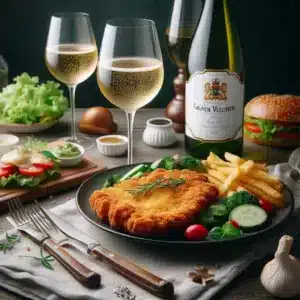
Let’s begin by acknowledging that each individual possesses a distinct sensitivity to flavors and aromatic elements. What might register as the same level of bitterness, for instance, could be notably more intense for one person compared to another.
This is not even about personal preference, it also depends on your inclinattions toward strong or mild reactions. These thresholds of sensitivity differ widely, mirroring the diversity of individual tastes.
Hence, what one person considers a “perfect” pairing could easily come across as commonplace or even unpleasant to another. It becomes evident that harmonizing food and wine must account for both individual preferences and sensitivities.
Foods introduce two components that can render wines more “hard” (increased astringency, bitterness, acidity, reduced sweetness and fruitiness): sweetness and umami. Conversely, two elements serve to make wines “softer” (diminished astringency, bitterness, acidity, heightened sweetness and fruitiness): saltiness and acidity.
ANECDOTE: To experience umami, one can simply compare the taste of a raw button mushroom to that of the same mushroom microwaved for 30 seconds—cooking significantly enhances its umami profile.
Its high acidity will enable it to pair well with citrus and deep-fried and fatty dishes to compensate the creamy taste. Austrian examples (as the saying goes : “What grows together, goes together“) would be the famous Wiener Schnitzel, creamy mushroom sauté or even a roasted chicken! In England, it would pair best with the famous fish&chips; or tempura.
Its spicy profile and high level of alcohol pairs well with spicy food such as Asian food such as spring rolls (fried and vegetable!), Asian curry, stir-fried noodles and dish with ginger basically.
Its freshness and light-body will make the perfect balance with seafood (oysters! my personal favourite. It works wonders with shrimpts also) and white fish (barbecued for me!)
Last, is herbaceous aromas makes it the perfect complement to green food, such as a vegetable tart or other dishes with vegetables and herbs. My preferred vegetables to pair with Grüner Veltliner would be artichokes and aspargus. For you fans of Brussels sprouts -if you still exist-, Grüner Veltliner’s your guy! (for those who hate Brussel sprouts, just down them with Grüner Veltliner!)
Concerning the Reserve, I would pair it cheese, and mostly creamy cheese, “fromages à pâte molle”, as we say in French, such as Brie for instance. It also works well with Mozzarella (a Burrata for example) and Halloumi (barbecued too !)
Age-Worthiness and Maturation
Grüner Veltliner wines often need five to ten years to fully express their complete potential. At their best, these wines rival with our Burgundy wines (this was actually proven during a blind tasting in London)
For the more modest Grüner Veltliner wines, such as liter bottlings or those falling within the $20 price range, I would recommend drking them while young because aging rarely brings much.
However, if you happen to have one of Wachau‘s favorites, such as Domäne Wachau Smaragd or Bründlmayer’s Alte Reben, thise wine can age for decades.
It was pointed out to me that the ’95 Brundlmayer Alte Reben was just now reaching maturity. The superior Gruner Veltliner demands ample time to unfold its secondary and tertiary complexities, ultimately proving that aging confers more rewards than initially anticipated.
For our Germany fans out there, the Wachau has a similar profile to the Mosel region in Germany : seemingly delicate grape varieties yielding wines capable of decades-long aging. Where the Mosel thrives with Riesling, the Wachau thrives with Grüner Veltliner.
As said earlier, Wachau’s climate ensure great acidity in the grapes and the long ripening period leads to exceptionnally concentrated wines. This unique combination is the foundation for long-lasting wines.
With age, it will develop aromas of honey and toast.
Additional tips for you!
When selecting a Grüner Veltliner wine, take a quick look at the label, this will help you choose.
Although “Klassik” isn’t always mentionned, “Reserve” is. So, if you can’t see any indication, it’s going to be a wine made in the “Klassik” way.
Moreover, since the mid-1980s, the regional protection association “Vinea Wachau” has classified the Wachau’s dry white wines into three categories based on their alcohol content.
Light and fruity wines up to 11.5% alcohol by volume are called “Steinfeder” (referring to the feather grass “stipa pennata”). The classic category (11.5% to 12.5% ABV) is named “Federspiel” (a term originating from falconry), while the heavier Reserve wines are known as “Smaragd” (starting from 12.5% ABV). The green lizards that inspired this designation, called “emerald lizards” in German, enjoy basking in the sun in the Wachau vineyards.
When it’s a “Ried” wine, meaning the grapes come from one vineyard, the name of vineyard is mentionned. Be on the lookout for : Loibenberg, Kellerberg, Klaus, Achleiten, Hochrain, Singerriedel, and Tausand-Eimer-Berg.
Last, I also drew a list of my favourite wineries in the Wachau region, feel free to check it at the end of this post.
Conclusion: Unique characteristics of Grüner Veltliner wine from Wachau
If you’ve reached the conclusion, congratulations because this was a long post. But what do you know, ther’s much to say about Grüner Veltliner!
So, with all that, what should you remember?
Grüner Veltliner became famous in the 1950s thanks to Lenz Moser’s high training method. This brought high yields but the wines were uninteresting.
Thanks to Wachau’s climate, good wines from Grüner Veltliner have a high acidity, herbaceous, citrus and white pepper aromas. They can age for a very long time and, then, develop aromas of honey and toast.
There are two ways Grüner Veltliner wines are made, either in the “Klassik” way, meaning the aging takes places in stainless steel tanks or in the “Reserve” way, where ageing takes place in new oak.
Due to its high acidity, its pepperish and herbaceous aromas and its freshness, Grüner Veltliner can pair with a number of wines from fish and spicy Asian food to fried and creamy dishes, flagships of Austrian cuisine.
In Austria, a lot of information is on the label. If you’re looking for the best, always choose Smaragd wines. These are usually also thoses with the highest alcohol level.
Tell me in the comments about the Grüner Veltliner wines you tasted!
As an Amazon associate I earn from qualifying purchases.




